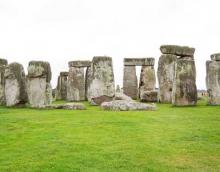
Photo courtesy of rupjones from Flickr Creative Commons.
People say that Stonehenge was built to be a giant calendar that marks the winter and summer solstices. To me, that claim has always seemed a little odd. Who would spend 1,500 years building a calendar out of stone? Invent paper, people.
But let’s think of a calendar in deeper terms. A calendar doesn’t just track the days of a year. It tells which days are significant and why: Mardi Gras, Passover, Tax Day, Bastille Day, Election Day, New Years. . . . More than that—a calendar tells us what we ought to be doing on these special days. It is a meeting place where we can plan our future. In that sense, Stonehenge is very much a calendar. It wasn’t meant just to track time, but to provide a space for people to come together for meaningful activity.
Your Class Calendar as a Meeting Place
If you’re like most teachers, you’re used to thinking of your class calendar as an organizational tool that you create to guide you through presentation of the material. It’s your plan. But what if your calendar could be a meeting place? What if you invited students into the process of building the calendar—or at least part of it?
Understand that the students wouldn’t be building the class calendar on their own. They would be participating with you in building it. Here’s an example of how you could build a calendar together:
- Display a calendar of the coming weeks. (Consider using a collaborative online program like Google Calendar.) Define the empty space that you and the students have to work in. “Over the next three weeks, we will be studying different biomes—or living environments for plants and animals.” Give your student an introduction to the topic—the more imersive and interactive the better.
- Ask students what they want to know about the topic. Get them to activate their prior knowledge and to come up with interesting driving questions. “I want everyone to take the next five minutes to write at least five interesting questions you want to answer about biomes. Then your table groups will meet for five minutes and discuss your questions. Each table group will present the three questions that are most interesting and that give you the most room to explore the topic.” Write down the top three suggestions from each table group.
- Read through the standards. Show your students exactly what you are supposed to cover. The standards are your common goals, and once students know the standards, they’ll be able to help you set up a calendar that addresses them.
- Sort through the driving questions. Ask students which of their driving questions will help them best learn the standards. Then ask them which questions they are most interested in pursuing. Narrow the field of questions down to a manageable number—say four. Then have each student choose a question that he or she wants to investigate. Each student will work individually on this question but will also collaborate with the other students who chose that question, in order to produce a group presentation.
- Have groups brainstorm ways they can investigate their questions. Remind students of all the resources they have—the textbook, the media lab, the library, the Internet. Ask them to think of community members who could help them explore the question. Ask if they know of any places where they could find out firsthand about their question. Ask what kind of individual and group projects they want to do to demonstrate their learning. (The last section of Inquire contains over 50 different projects students could create, from glogs and speeches to videos and campaigns.)
- Build a rubric together. With students, discuss the standards, the driving questions, and the proposed projects. Ask them to indicate what excellence will look like, what good work will be, and what poor work will be. Students will suggest some pretty high standards, and if they don’t, you can bump up the difficulty. When students participate in writing the rubric, they own it. You won’t be grading them so much as they will be grading themselves.
- Return to your calendar and build your Stonehenge. Now you and your students can collectively set up milestones: research time, group meetings, project plans, guest visits, outings, group presentations. . . . Instead of building all this yourself and then walking your students through it, you are using your calendar as a meeting place that creates a community of learners.
Stonehenge Wasn’t Built in a Day
True, it took 1,500 years to build Stonehenge, but while the community built it, Stonehenge built the community. In a class period or two, you and your students can build your own calendar—a space to meet for meaningful activity. And next year, when you return to the “biome unit,” you’ll have all kinds of examples of what the previous generation built. A new community of learners can gather in the same basic space and discover what the calendar means for them.
We want to hear from you! What ways have you discovered for providing students choice in your classroom? How do you clear a space to invite community? Please enter your comments below.